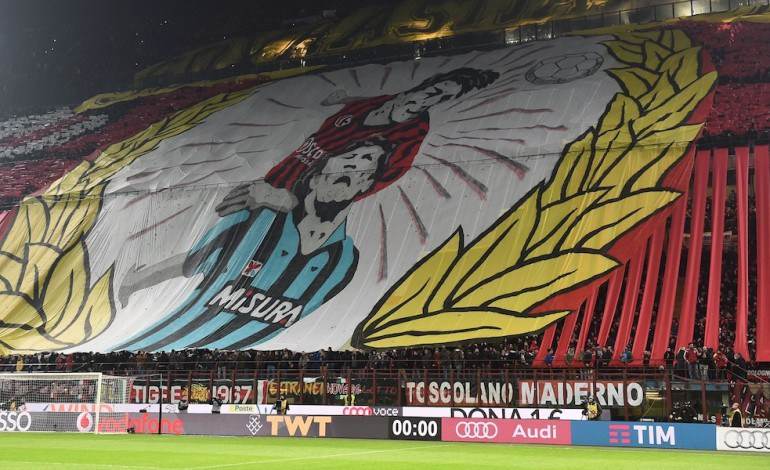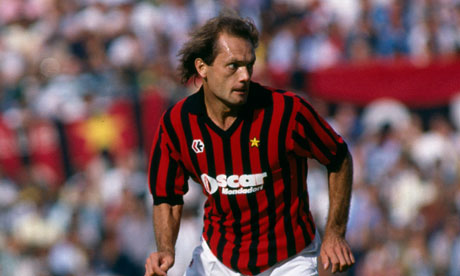I went to Milan and had an absolute ball of a time.
In the summer of 1984, two of football’s most distinguished names earned record breaking moves to Serie A. Diego Maradona left Barcelona to join Napoli for £6.9 million (then a world record fee) and Karl-Heinz Rummenigge left Bayern Munich to join Inter for €5.7m. Accompanying these two superstars, and joining the likes of Zico (Udinese), Falcao (Roma), Socrates (Fiorentina) and Michel Platini (Juve) in the world’s most glamorous league, was an Englishman by the name of Ray Wilkins. Sold by Manchester United to AC Milan for £1.5m, the England international spent three years in Italy and established himself as a bulwark of the Rossoneri midfield.
The former Manchester United man arrived at San Siro during a tumultuous era for the club. The Diavolo had just fought their way back into Serie A after having been relegated in 1980 due to the Totonero betting scandal, and again in 1982 after desperately poor performances on the field. Milan were in transition. However, led by Swedish coach Nils Liedholm, the wounded giants began to establish themselves once again and they looked to the British Isle for inspiration.
Indeed, Wilkins was not the only Englishman to move to AC Milan in 1984. Portsmouth forward Mark Hateley joined him that summer and by Wilkin’s own admission, this helped the pair settle in Italy, although it did little to improve their linguistic skills. Nevertheless, Wilkins soon grew to love the country, it’s ‘Stile di Vita’ and especially its passion for football.
A crafty and industrious player, Wilkins slotted seamlessly into Liedholm’s 4-1-3-2 formation, playing centrally in the Rossoneri’s midfield trident. Although he was never renowned for his goal scoring or creative flair, the Englishman was a ubiquitous presence on the field. His dynamism and intelligence allowed him to contribute to both facets of the game, intercepting passes and harrying opponents when defending, whilst keeping the ball moving and providing a link between midfield and attack when in possession.
In his first season, he helped the club to a fifth-place finish and qualification for the UEFA Cup. The England international was also integral to Milan’s Coppa Italia campaign. Unfortunately for Wilkins, the Rossoneri were beaten finalists, losing 3-1 over two legs to a Sampdoria side which boasted the likes of Roberto Mancini, Gianluca Vialli and Graeme Souness.
It was during this debut season that Wilkins enjoyed some of his fondest moments in Italian football, particularly in games against Inter and Juventus. The Englishman was especially enchanted by the feverish atmosphere of the Derby della Madonnina and he remembers his first experience of the fixture vividly. “…Blue and black at one end, red and black at the other, the smoke meeting in the middle, it was something quite fantastic,” Wilkins later told Channel 4’s Football Italia show.
This abiding memory was made that much sweeter by the Rossoneri’s famous victory, ending a barren spell of six years without a win in the Derby. In fact, it was very much a day for Milan’s Englishmen, as Mark Hateley headed home a thumping winner to write his name in Red and Black folklore.

Read – ‘Mark ‘Attila’ Hateley: AC Milan’s derby day hero’
Later that season, Wilkins would have an equally important role in the Diavolo’s triumph over Platini’s Juventus. In an interview with Sky Sports in 2013, remembering the colossal clash the English midfielder said: “I thought I’d scored a crucial goal but it just came off the head of Pietro Paolo Virdis and if you try to nick a goal off your centre-forward’s head, you haven’t got a prayer. We beat them 3-2 but it was one hell of a game.”
The following season was overshadowed by Milan’s travails off the pitch. Their president, Giuseppe Farina, went into exile in South Africa after he was suspected of stealing money from club, which paradoxically proved the harbinger for the most successful era in Milan’s history. At the end of the 1985/86 season, media tycoon Silvio Berlusconi bought Milan and he quickly set about implementing his new vision.
Wilkins spent just one year under the tenure of Berlusconi and in 1987 he was sold as a makeweight for the imminent arrival of the Dutch triumvirate, Marco Van Basten, Ruud Gullit and Frank Rijkaard. Looking back on his departure, even Wilkins admitted that competing with this calibre of players would have been a bridge too far.
When you’ve got the likes of Gullit, Van Basten and Rijkaard coming in there are not too many players who can keep them out of the team and Mark and I certainly weren’t good enough to keep them out.
The quote encapsulates Wilkins as a player; honest, humble and intelligent. In 73-appearances, he mustered two goals, but it was the aforementioned traits that made him a hit with the Rossoneri. He marvelled at the technical and tactical precision of the Italian game and he quickly embraced it, elegantly governing the Milan midfield.
Granted Wilkins didn’t win any silverware in Italy. However, this Brit abroad was an ever-present cog in a team which laid the foundations for a Milan side which became one the greatest forces European football has ever seen. Wilkin’s Milan may not have been part of the immortals, but his side were certainly trailblazers.

